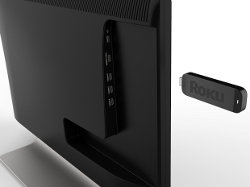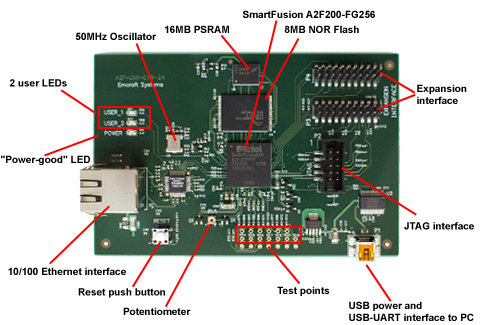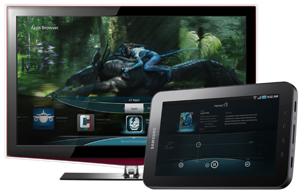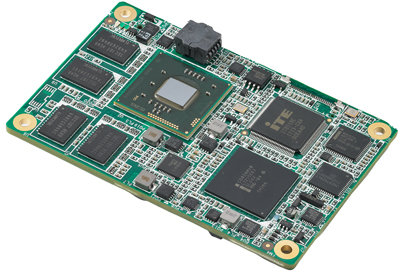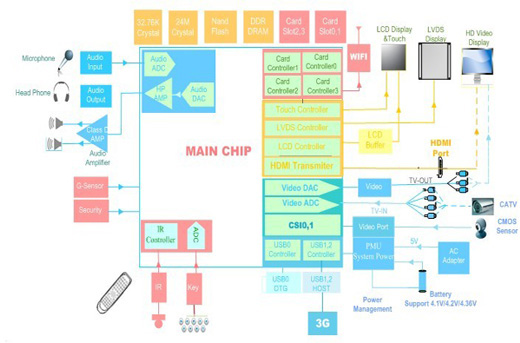Roku has unveiled the Roku Streaming Stick – an HDMI dongle about the size of a standard USB flash drive that will simply plug into a TV to instantly transform it into a Smart TV. It basically includes everything you’d find in a Roku player (built-in WiFi, processor, memory and software) and will deliver all the channels present on the Roku platform. It will be possible to use just one remote for the TV and for streaming and no cables or power adaptor are needed. Another advantage of the Roku stick, is that when it becomes outdated and the hardware needs to be upgraded to be able to take advantage of new software capabilities, it’s possible to simply purchase a new low cost Roku Streaming Stick (or another equivalent product) without having to replace the much more expensive TV. The Roku Streaming Stick will plug into MHL-enabled HDMI ports on […]
Video Demo of XMBC on Raspberry Pi
XMBC is a free and open source (GPL) software media player and entertainment hub for digital media. Some people are currently working on porting it to the Raspberry Pi board. They posted a video demo on their forum and I uploaded the video to YouTube for those interested in seeing the progress. The video just shows XMBC booting, then accessing the menu and showing the Videocore GPU is detected. This is still work in progress, but it looks promising. Jean-Luc Aufranc (CNXSoft)Jean-Luc started CNX Software in 2010 as a part-time endeavor, before quitting his job as a software engineering manager, and starting to write daily news, and reviews full time later in 2011. www.cnx-software.com
Raspberry Pi Beta Boards Are Being Auctioned
The Raspberry Pi foundation has setup an Ebay account and made some of the Raspberry Pi Beta Board Model B (Ethernet + 256 MB RAM) available on Ebay. This is for charity so you won’t be able to get them for 35 USD… The current bid is 1,320.00 GBP (2050 USD). They’ll add 2 boards on Ebay each day. The goal of this auction is to gather funds in order to hire a full-time staff and give as many Raspberry Pi away to kids as possible. If you win the bid, you’ll get one of the 10 boards for sale, a USB power, an SD card with Debian, and some kind of certificate showing you were one of the first to get a board. If you are interested, you can bid at http://www.ebay.co.uk/itm/Raspberry-Pi-Model-B-beta-board-10-limited-series-10-/180786734741?pt=LH_DefaultDomain_3&hash=item2a17baa695 Jean-Luc Aufranc (CNXSoft)Jean-Luc started CNX Software in 2010 as a part-time endeavor, before quitting his job as […]
Linux for Cortex M3 & M4 Microcontrollers
There are plenty of low cost Linux development boards based on Cortex A8 or A9 such as the Beaglebone, as well as some devkits based on ARM7 and ARM9 such as SAM9 development kits , but if your application is cost and/or energy sensitive you can also switch to micro-controllers using Cortex M3 or M4 based development boards such as Emcraft SmartFusion devkits. You can run a functional uCLinux system with 1MB of RAM and 1MB of flash including the TCP/IP stack. You need to use uClinux and not directly Linux, because the Cortex M3 doess not have a Memory Management Unit (MMU) and only a Memory Protection Unit (MPU). This can bring some interesting software development challenges such as (apparently random) kernel panics, the lack of fork, memory fragmentation and more. You can check out http://kernel.org/pub/linux/libs/uclibc/Glibc_vs_uClibc_Differences.txt for the main differences between uClibc and Glibc. The instructions to patch and […]
Myriad Alien Vue Brings Android to Your TV
Myriad Group, a company based in Switzerland, brings Android (and a Google TV alternative) to non-Android platforms through its Alien Davlik technology, called Myriad Alien Vue. Alien Vue is a solution that enables TV service providers to add apps to their existing managed service offerings, in order to respond to over-the-top (OTT) content distribution channels from Apple, Google and others. It is compatible with apps developed using HTML5 and most Google TV apps such as YouTube, Netflix and Twitter apps. The release includes an app store developed in conjunction with AppCarousel that can be fully be customized / branded by service providers. Myriad Alien Vue also supports additional plug-in components like Myriad Connect & Share, providing multi-screen functionality for personal and premium content. Alien Vue allows to leverage existing TV and set-top box equipment and works with mobile phones and tablets to give users control over their TV experience. Alien […]
Advantech Announces COMs, SBCs, Motherboards and Embedded PCs based on Intel Atom N2000 and D2000 Series
Advantech has updated its product range by adding Computer On Modules (COMs). single board computers (SBCs), industrial motherboards and embedded box PCs based on the latest Intel Atom N2000 and D2000 Series processors to its offerings. These low-power embedded platforms provide energy-efficient solutions, and serve a wide range of applications targeted at handheld devices, POS, kiosks, digital signage, medicine, and factory automation. Computer On Modules: SOM-7565 and SOM6765 The Advantech COM-Express Mini SOM-7565, with a mere 84 x 55 mm board size, benefits the low power consuming handheld devices market. SOM-7565 Key Features: PICMG COM R2.0 compliant module for Intel Atom processors N2600 Intel gfx support for DirectX 9 and Open GL 3.0 Supports 18-bit LVDS, eDP/HDMI/DVI/DisplayPort Onboard 2 GB DDR3 800 memory and 4 GB SSD Supports 3 PCIe x1, LPC, SMBus, I2C Bus, SATAII, 8 USB2.0, and GbE Supports Advantech iManager 2.0 and software APIs The COM-Express Compact […]
AllWinner A10/A1X Processor Resources, Development Board and SDK
AllWinner A10 (part of A1X series) is an ARM Cortex A8 SoC targetting multimedia products such as tablets, HD STB or digital signage. It is currently found in some low cost Android tablets such as Momo9C and will be used in Rhombus Tech’s Raspberry Pi alternative. The processor features an ARM Cortex A8 clocked at 1.5 Ghz with a Mali-400 GPU. It can support 1080p encoding/decoding, provides HDMI, Component, Composite, VGA and LVDS video outputs, USB2.0 ports, a SATA 2.0 port and more… Here are the key features of the Allwinner A10: VPU (Video Processing Unit) HD Video Decoding (Super HD 2160P/3D Film) Support all popular video formats, including VP8, AVS, H. 264 AVC, VC-1, MPEG-1/2/4, … HD Video Encoding (H.264 High Profile) Support encoding in H.264 format DPU (Display Processing Unit) MULTI-CHANNEL HD displays Built-in HDMI YPbPr, CVBS, VGA LCD interfaces: CPU, RGB, LVDS up to Full HD Memory […]
Android Drivers Will Be Included in Linux Kernel 3.3
The Android drivers were no longer accepted in the mainline Linux kernel, starting with Linux kernel 2.6.33, as announced by Greg Kroah-Hartman back in spring 2010. But this is about to change, as it appears that Greg Kroah-Hartman will include the Android drivers into his development branch for the upcoming Linux kernel 3.3, making it boot on Android devices without being patched. The Linux Foundation’s Consumer Electronics workgroup, along with a group at Linaro and various individual developers, is working with Kroah-Hartmann on this project. Tim Bird, chair of the Architecture Group, announced the Android Mainlining Project on the 20th of December with the goal of coordinating work on integrating the Android features. Further information on this project is available on the wiki and developers can also sign up for the project’s mailing list to join the 15 other persons involved in the project. Jean-Luc Aufranc (CNXSoft)Jean-Luc started CNX Software […]


